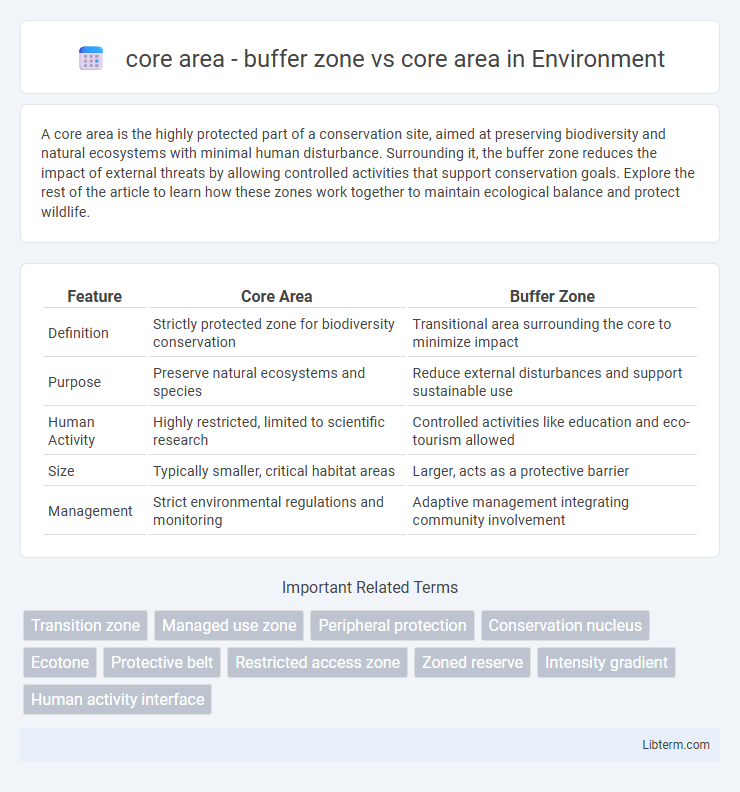A core area is the highly protected part of a conservation site, aimed at preserving biodiversity and natural ecosystems with minimal human disturbance. Surrounding it, the buffer zone reduces the impact of external threats by allowing controlled activities that support conservation goals. Explore the rest of the article to learn how these zones work together to maintain ecological balance and protect wildlife.
Table of Comparison
| Feature | Core Area | Buffer Zone |
|---|---|---|
| Definition | Strictly protected zone for biodiversity conservation | Transitional area surrounding the core to minimize impact |
| Purpose | Preserve natural ecosystems and species | Reduce external disturbances and support sustainable use |
| Human Activity | Highly restricted, limited to scientific research | Controlled activities like education and eco-tourism allowed |
| Size | Typically smaller, critical habitat areas | Larger, acts as a protective barrier |
| Management | Strict environmental regulations and monitoring | Adaptive management integrating community involvement |
Understanding the Concept of Core Area
The core area represents the central, most protected zone within a conservation reserve, characterized by minimal human interference to preserve biodiversity and ecological processes. It contrasts with the buffer zone, which surrounds the core area and permits controlled human activities that support conservation objectives without compromising the core's integrity. Understanding the concept of the core area is crucial for effective habitat preservation, ensuring species protection and maintaining ecosystem stability.
Defining Buffer Zone: Purpose and Importance
The buffer zone serves as a protective barrier surrounding the core area, designed to mitigate external threats and preserve ecological integrity. It plays a critical role in maintaining biodiversity by regulating human activities and reducing environmental impact on the core area. The strategic management of buffer zones enhances conservation efforts and supports sustainable land use around critical habitats.
Core Area vs Buffer Zone: Key Differences
Core areas are strictly protected zones primarily designated for biodiversity conservation and ecosystem preservation, where human activities are highly restricted or prohibited. Buffer zones act as transitional areas surrounding core zones, allowing regulated activities such as sustainable resource use, research, and limited tourism to minimize negative impacts on the core area. The key differences lie in the level of protection and permissible use, with core areas emphasizing strict conservation, while buffer zones provide a protective barrier enabling controlled human interaction.
Ecological Functions of Core Areas
Core areas serve as undisturbed habitats that sustain biodiversity, maintain population viability, and facilitate natural ecological processes. Buffer zones surround core areas to mitigate external pressures such as human activity, pollution, and invasive species, enhancing the core area's ecological integrity. The effectiveness of core areas in preserving critical ecological functions depends on the size, connectivity, and management of both the core and its buffer zone.
The Role of Buffer Zones in Conservation
Buffer zones play a crucial role in conservation by acting as transitional areas that reduce human impact on core areas, which are strictly protected regions focused on preserving biodiversity and ecosystems. These buffer zones support sustainable resource use, habitat connectivity, and mitigate external threats such as pollution and invasive species, thereby enhancing the resilience of core zones. Effective management of buffer zones improves species survival rates and maintains ecosystem services critical to conservation goals.
Zoning Strategies in Protected Areas
Zoning strategies in protected areas often designate the core area as strictly protected with minimal human intervention to preserve biodiversity and ecological processes. The buffer zone surrounding the core area permits regulated activities like sustainable resource use and research, reducing external impacts on the core zone. Effective delineation between core and buffer zones enhances conservation outcomes by balancing ecosystem protection with community engagement.
Biodiversity Protection: Core vs Buffer Approaches
Core areas serve as strictly protected zones where biodiversity thrives without human interference, preserving critical habitats and endangered species. Buffer zones surround these core areas and are managed to mitigate external impacts, allowing sustainable activities that support conservation goals. The combined approach enhances ecosystem resilience by reducing habitat fragmentation and maintaining genetic diversity.
Human Activities: Restrictions in Core and Buffer Zones
Core areas enforce strict prohibitions on human activities such as logging, hunting, and agriculture to preserve biodiversity and ecosystems. Buffer zones allow regulated human activities like sustainable farming, eco-tourism, and resource harvesting under controlled conditions to minimize environmental impact. These restrictions in core versus buffer zones maintain ecological integrity while balancing conservation with community livelihoods.
Management Challenges: Balancing Core and Buffer Needs
Balancing management challenges between core areas and buffer zones involves addressing strict conservation goals while accommodating sustainable human activities. Core areas require minimal human disturbance to protect biodiversity, whereas buffer zones serve as transitional regions supporting controlled use and reducing external pressures. Effective coordination ensures that buffer zone activities do not compromise the ecological integrity of adjacent core areas.
Case Studies: Effective Use of Core and Buffer Zones
Case studies from Yellowstone National Park and Sundarbans demonstrate how core areas strictly conserve biodiversity by restricting human activity, while buffer zones allow sustainable resource use and community involvement, thus reducing encroachment and enhancing ecosystem resilience. In these regions, the core area's legal protection ensures habitat preservation for endangered species, whereas buffer zones serve as transitional spaces mitigating human-wildlife conflicts. Effective zoning balances conservation goals with local livelihoods, highlighting the critical role of integrated management strategies in protected area success.
core area - buffer zone Infographic

 libterm.com
libterm.com